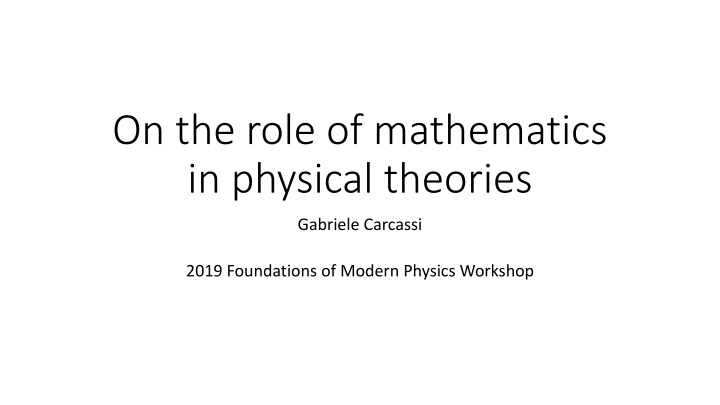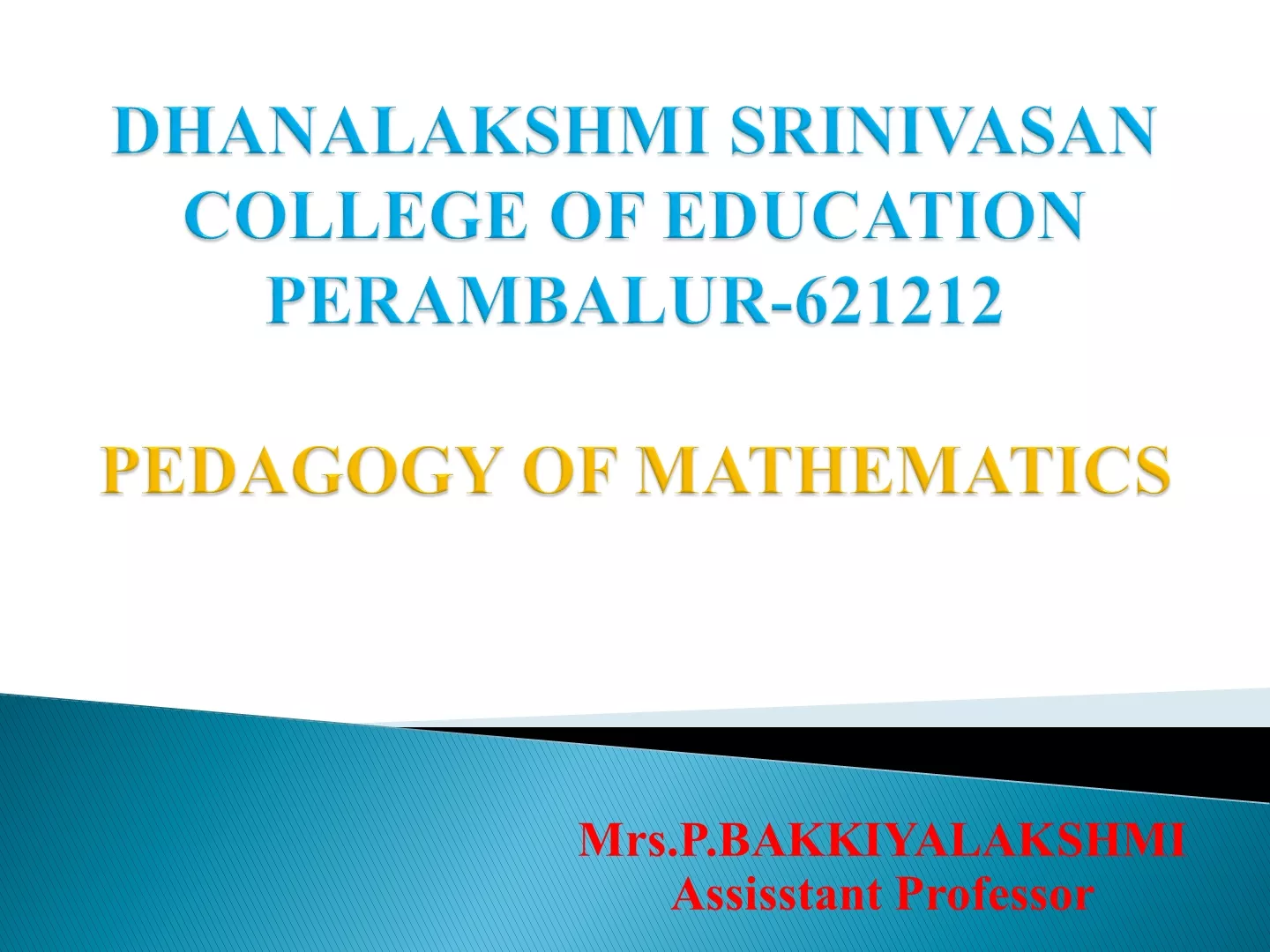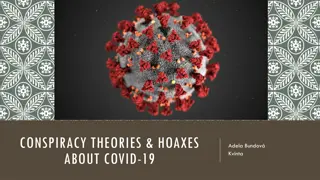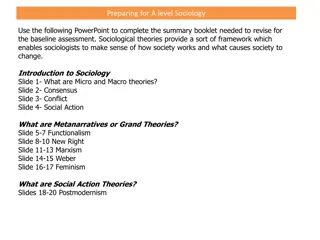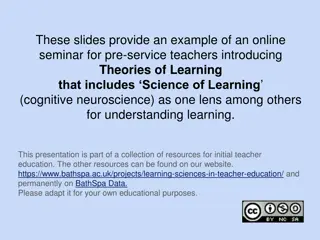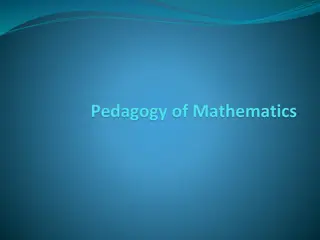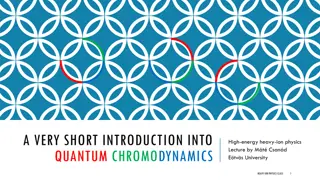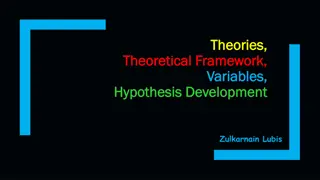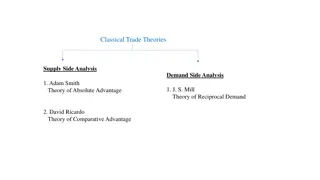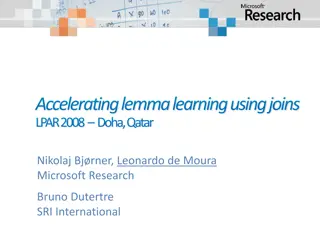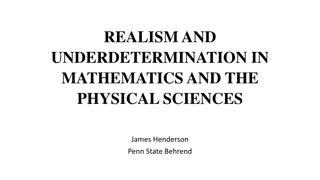The Role of Mathematics in Physical Theories - Insights from Gabriele Carcassi's Work
Exploring the technical function of mathematics within physical theories, Gabriele Carcassi's research delves into developing a general mathematical theory of experimental science. This theory aims to derive the basic laws of physics from a handful of physical principles and assumptions, providing a formal framework that clarifies assumptions and yields mathematical objects with clear physical meanings. By studying scientific theories through a mathematical lens, this work offers a deeper understanding of the laws of physics and their representations.
Download Presentation

Please find below an Image/Link to download the presentation.
The content on the website is provided AS IS for your information and personal use only. It may not be sold, licensed, or shared on other websites without obtaining consent from the author.If you encounter any issues during the download, it is possible that the publisher has removed the file from their server.
You are allowed to download the files provided on this website for personal or commercial use, subject to the condition that they are used lawfully. All files are the property of their respective owners.
The content on the website is provided AS IS for your information and personal use only. It may not be sold, licensed, or shared on other websites without obtaining consent from the author.
E N D
Presentation Transcript
On the role of mathematics in physical theories Gabriele Carcassi 2019 Foundations of Modern Physics Workshop
Before we start Disclaimer: we are not going to talk in general of the role of mathematics in science. Just its role within a physical theory. By role we mean its technical function, what it formally captures We are not going to discuss sociological roles, inspiration roles, etc The viewpoint presented here is profoundly shaped by our work on our project Assumptions of Physics It forced us to understand where the line between scientific theories and mathematical frameworks is
Assumptions of Physics The aim of the project is to find a handful of physical principles and assumptions from which the basic laws of physics can be derived (see http://assumptionsofphysics.org) To do that we need to develop a general mathematical theory of experimental science: the theory that studies scientific theories A formal framework that forces us to clarify our assumptions From those assumptions the mathematical objects are derived Each mathematical object has a clear physical meaning and no object is unphysical Gives us concepts and tools that span across different disciplines Gives us a better understanding of what the laws of physics are and what they represent
General mathematical theory of experimental science Experimental verifiability leads to topological spaces, sigma-algebras, State-level assumptions Irreducibility leads to quantum state space Infinitesimal reducibility leads to classical phase space Process-level assumptions Hamilton s equations Deterministic and reversible evolution leads to isomorphism on state space Schroedinger equation ? ???,? = ?? ??, ?? ?? ? ? ??? = ?? Thermodynamics Non-reversible evolution Euler-Lagrange equations Kinematic equivalence leads to massive particles ? ? ?, ?,? = 0
Outline First we will get familiar with the basic ideas We do not have time to see all details, but we have to see at least some parts to get a sense of what it means to properly formalize scientific concepts We will present a formalism to properly capture semantic properties and relationships of the type we have in science and see how this formalism leads necessarily to topologies and sigma-algebras (the foundations of differential geometry, measure theory, probability theory, ) Once we have seen exactly how physical concepts are encoded into mathematical structures, we can draw conclusions
The principle of scientific objectivity tells us that science deals with assertions that are: either true or false (non-contradictory) for everybody (universal) and experimentally verifiable (evidence-based) We call such assertions verifiable statements The first two requirements are the same as in classical logic The third means we have an experimental test that we can run and, if the statement is true, it completes successfully in finite time
Examples of verifiable statements Examples: The mass of the photon is less than 10 13 eV If the height of the mercury column is between 24 and 25 millimeters then its temperature is between 24 and 25 Celsius If I take 2 0.01 Kg of Sodium-24 and wait 15 0.01 hours there will be only 1 0.01 Kg left Counterexamples: Chocolate tastes good (not universal) It is immoral to kill one person to save ten (not universal and/or evidence-based) The number 4 is prime (not evidence-based) This statement is false (not non-contradictory) The mass of the photon is exactly 0 eV (not verifiable due to infinite precision) We need a mathematical framework to capture these concepts
Statements In mathematical logic, statements are sentences constructed from a well defined set of symbols I.e. , , , , ,?,?,?, They are so defined to avoid paradoxes, the web of meaning and therefore give a rigorous foundation to mathematics, study proof theory, etc This does not work for us Science started well before we had those symbols Science is about the web of meaning In science, statements are the assertions represented by the sentences This animal is a cat is the same statement as Quest animalee un gatto The desk is 1 meter wide is the same statement as The desk is 3.28083989501 feet wide
Statements Statements themselves are not formally defined We are not going to try to define a grammar or try to specify what meaning means, we just have symbols to represent them mathematically but we axiomatically give them properties from which we can construct formal propositions E.g. truth ?1 = TRUE
Assignments In mathematical logic, logical relationships are defined by their truth value For example ? ? is false if ? is true and ? is false Therefore 4 is a prime number implies ?is transcendental Moreover, the semantic is said to define what is true or not true This does not work for us This animal is a dog implies this animal is a mammal is about what we could possibly find, not on whether it happens to be true or not The meaning (i.e. the semantic) of Secretariat will win the race tomorrow is clear even if we don t know the truth value In science, the truth is found experimentally and the semantic has to be clear before we run the tests Logical consistency is about what hypothetical truths we can find within a certain model For example, this animal is a cat and this animal is a dog can t be both assigned true
Assignments As with statements, we don t try to formalize how the possible assignments are derived It would require meaning but we axiomatically give them properties from which we can construct formal propositions
Statements as functions of other statements This allows us to create functions of statements In particular, we have negation (logical NOT), conjunction (logical AND) and disjunction (logical OR) Note that logical operators are not symbolic connectors They are algebraic operations
Formal system for informal statements Those three axioms are enough to capture all the semantic structure we need to guarantee logical consistency even on informal statements Any set of consistent statements that have a universal truth will fit the axioms A set of inconsistent statements violates the second axiom as there would be no possible assignment
Statement equivalence They allow to distinguish between different notions of equivalence Are the same statement This animal is a bird = Questo animale e un uccello This animal is a bird This animal has feathers truth( This animal is a bird ) = truth( That animal is a mammal ) Must have the same truth Happen to have the same truth
Tautologies and contradictions We can distinguish between statements based on the truth values they are allowed This swan is a bird is a tautology, This cat is a dog is a contradiction and This animal is a cat is contingent
Other semantic relationships For example: narrower than This animal is a cat This animal is a mammal incompatible This animal is a cat This animal is a dog independent This animal is a cat This animal is black
Logical context as an algebraic structure We can prove that a logical context is a complete Boolean algebra, that narrowness imposes a partial order, The algebraic structure we defined on the logical context captures the minimum logical and semantic relationships between our statements to guarantee universality and non-contradiction Any further structure we impose on a logical context to capture other semantic relationships will need to interact with the previous structure in a well defined manner That is, the notions of equivalence, independence, ordering, etc defined on this structure will be inherited in some fashion by all other structures
Verifiable statements Now that we have a framework rich enough to capture all the statement relationships we need, we turn our attention to experimental verification A statement is verifiable if we have a repeatable procedure that terminates successfully in finite time if and only if the statement is true This is hard to define formally so we won t Note that not all statements are experimentally verifiable We can verify that there exists extra-terrestrial life or that the mass of the photon is less than 10-18 eV We cannot verify that there exists no extra-terrestrial life or that the mass of the photon is exactly 0 eV
Verifiable statements What makes a statement verifiable is not formally defined There is a sense that trying to fully specify what can be measured is equivalent to already knowing the laws of physics But we have to ask: under what operations is the set of verifiable statements closed? Is it a Boolean algebra?
Logic of verifiable statements We can t always test negation The test is not guaranteed to terminate if the test is unsuccessful If we can, we say the statement is decidable We can always test the finite conjunction Just test one statement at a time: if they are all true all tests will terminate in finite time We cannot have infinitely many tests though: we wouldn t terminate in finite time We can always test the countable disjunction Once just one test terminates successfully, we are done We cannot extend to uncountably many: we wouldn t be able to find the test that terminates in finite time
Comparing algebras ?? ?? ?
Sets of verifiable statements Now that we have captured how we verify single statements, what can we say about verifying a collection of statements? Specifically, what s the biggest set of verifiable statements we can verify? Clearly, we do not need to run the test for all the elements Once we verify that ?1 is true we already know that ?1 ?2 is also true
Basis What is the biggest basis we can experimentally test? A countable set Even with unlimited time, we can only test countably many statements
Experimental domain This represents the biggest set of verifiable statements we can test Any scientific theory, in the end, is equivalent to a set of verifiable statements, which forms at most an experimental domain
Predictions Science is also about making predictions, but not all predictions are directly verifiable For example, there exists no extra-terrestrial life predicts that the test for there exists extra-terrestrial life is never going to terminate While we cannot always experimentally confirm negation, it still makes sense logically as a possible way things could be
Theoretical domain This represents all statements that give meaningful predictions to (and only to) the verifiable statements in the domain
Possibilities for the domain Among all the predictions we look for the ones that give the full picture For example, if we knew This animal is a cat to be true, we would also know that This animal has whiskers and This animal is a mammal are true while This animal has feathers is false
Possibilities for the domain A possibility, if true, gives a prediction for all theoretical and verifiable statements The set of possibilities corresponds to all the cases we can experimentally distinguish given the experimental domain
Start with a countable set of verifiable statements (the most we can verify experimentally) Basis ? ?? ?? ??
Construct all verifiable statements that can be verified from the basis (close under finite conjunction and countable disjunction) Basis ? Verifiable statements ?? ?? ?? ?? ??= ?? ?? ??= ?? ??
Construct all statements that give a prediction for those verifiable statements (close under negation as well) Basis ? Verifiable statements ?? Theoretical statements ?? ?? ?? ?? ??= ?? ?? ??= ?? ?? ??= ?? ?? ??= ??
Consider all truth assignments: it is sufficient to assign the basis Basis ? Verifiable statements ?? Theoretical statements ?? ?? ?? ?? ??= ?? ?? ??= ?? ?? ??= ?? ?? ??= ?? F F F F F T T F T F T F F T T T F T F T F
Remove truth assignments that are not possible Basis ? Verifiable statements ?? Theoretical statements ?? ?? ?? ?? ??= ?? ?? ??= ?? ?? ??= ?? ?? ??= ?? F F F F F T T F T F T F F T T T F T F T F
Each consistent truth assignment is associated with a possibility of the domain Basis ? Verifiable statements ?? Theoretical statements ?? ?? ?? ?? ??= ?? ?? ??= ?? ?? ??= ?? ?? ??= ?? F F F F F T T Possibilities? F T F T F F T T T F T F T F ? = ?? ?? ?? For each consistent truth assignment we have a minterm that is true only in that case. Each minterm is a possibility of the domain.
Each consistent truth assignment is associated with a possibility of the domain Basis ? Verifiable statements ?? Theoretical statements ?? ?? ?? ?? ??= ?? ?? ??= ?? ?? ??= ?? ?? ??= ?? F F F F F T T Possibilities? F T F T F F T T T F T F T F ? = ?? ?? ?? The role of logic (and math) in science is to capture what is consistent (i.e. the possibilities) and what is verifiable (i.e. the verifiable statements) and the corresponding logical relationships For each consistent truth assignment we have a minterm that is true only in that case. Each minterm is a possibility of the domain.
Each consistent truth assignment is associated with a possibility of the domain Basis ? Verifiable statements ?? Theoretical statements ?? ?? ?? ?? ??= ?? ?? ??= ?? ?? ??= ?? ?? ??= ?? F F F F F T T Possibilities? F T F T F F T T T F T F T F ? = ?? ?? ?? For example, verifiable statements corresponds to open sets in a topology while theoretical statements correspond to Borel sets in a ?-algebra For each consistent truth assignment we have a minterm that is true only in that case. Each minterm is a possibility of the domain.
Basis ? Verifiable statements ?? Theoretical statements ?? ?? ?? ?? ??= ?? ?? ??= ?? ?? ??= ?? ?? ??= ?? F F F F F T T Possibilities? F T F T F F T T T F T F T F The lines of the truth table (i.e. the possible assignments) are the points
Basis ? Verifiable statements ?? Theoretical statements ?? ?? ?? ?? ??= ?? ?? ??= ?? ?? ??= ?? ?? ??= ?? F F F F F T T Possibilities? F T F T F F T T T F T F T F Each column is a set (i.e. the set of possibilities that are true in that column)
conjunction and disjunction becomes intersection and union Basis ? Verifiable statements ?? Theoretical statements ?? ?? ?? ?? ??= ?? ?? ??= ?? ?? ??= ?? ?? ??= ?? F F F F F T T Possibilities? F T F T F F T T T F T F T F The experimental domain is the topology (i.e. each verifiable statement is an open set)
Basis ? Verifiable statements ?? Theoretical statements ?? ?? ?? ?? ??= ?? ?? ??= ?? ?? ??= ?? ?? ??= ?? F F F F F T T Possibilities? F T F T F F T T T F T F T F The basis of the experimental domain is a sub-basis of the topology
negation and countable disjunction becomes complement and countable union Basis ? Verifiable statements ?? Theoretical statements ?? ?? ?? ?? ??= ?? ?? ??= ?? ?? ??= ?? ?? ??= ?? F F F F F T T Possibilities? F T F T F F T T T F T F T F The theoretical domain is the ? ?-algebra (i.e. each theoretical statement is a Borel set)
Logical consistency and mathematics Mathematical structures deal with logical consistency Most mathematicians, in fact, focus on whether the objects are well defined and not whether they can be found in practice (e.g. axiom of choice) As we want science to be logically consistent, physical theories will be mathematical structures but not all mathematical structures can be physical theories For example, as an experimental domain must have a countable basis, the cardinality of the possibilities (the cases we can distinguish experimentally) is at most that of the continuum
Mathematics captures the semantic structure Experimentally verifiable statements are represented by topologies Theoretically sound statements are represented by ?-algebras Composition of parts into wholes is represented by vector spaces Objects whose description can be given by a set of numbers are represented by manifolds Descriptions with commensurable quantities give rise to geometrical structures If our objects allow distributions and densities then they are represented by differentiable manifolds If those densities are coordinate invariant then we have symplectic manifolds Deterministic and reversible evolution is logical equivalence between statements about future and past states which leads to isomorphism in whatever category is used to describe states
Mathematics captures the semantic structure Once the semantic structure of the theory is made clear, the mathematical structure follows and there is a perfect mapping between mathematical concepts and physical concepts Every mathematical theorem can be read line by line as a physical argument If there is no perfect mapping, then either the theory is incomplete (i.e. some physical concept is not captured by the mathematical framework) or not completely physical (i.e. some mathematical objects do not correspond to physical ones) The converse is not true, even if the mathematical structure of a theory is made clear, its semantic structure cannot be reconstructed Two different scientific theories can have the same mathematical structure
Science Math is a forgetful functor (Mathematics is meaningless) Note that the way we made our discourse precise was not by making everything precise but by dropping what couldn t be made precise What is the meaning of a statement, what does it mean for it to be true, how does the meaning rule out assignments, when can we say that a statements is verifiable, these cannot be formalized But what is left out is the actual physics the fact that those symbols represent statements in the real world, that the labels we use to identify statements represent quantities that correspond to specific measurements, that those statements have relationships
Reformulation A model change, then, can then happen in two ways: within the same context or by changing context altogether If the context/experimental domain is the same, we have a purely mathematical reformulation the meaning of the statements must remain the same, what is verifiable is the same we can only change how the relationships are captured mathematically If the context/experimental domain is different, we have a different physical theory the meaning of the statement may change, how tests are mapped to statements may change unavoidable with new experimental techniques, different assumptions, whether or not the mathematical structure is the same is inconsequential Naturally, model changes are a continuum, they are never formalized, so whether a particular case falls in one category or the other can be a matter of opinio
Conclusion Mathematics studies logically consistent structures Science studies theories and models that are not only logically consistent, but are universal and allow experimental verification The mathematical structures we use in physics (e.g. topology, ?-algebras, measures, metrics, ) are there precisely to keep track of the logical structures of statements: how are they logically related, which ones are verifiable, which ones are more precise and by how much, and so on As we are developing a general mathematical theory for experimental science, we had to clearly demarcate the line between scientific ideas and mathematical ideas The result is that the only role mathematics has within a physical theory is to keep track of logical/semantic relationships between scientific statements within the theory. For example: If that animal is a dog is true then that animal is a cat is not true The mass of the photon is less than 10^-10 eV can be verified experimentally while the mass of the photon is exactly 0 cannot be verified experimentally If within the volume V there is 1 Kg of gaseous helium is true then within the volume v there is 1/2 Kg of gaseous helium is true for some sub volume v
General mathematical theory of experimental science Experimental verifiability leads to topological spaces, sigma-algebras, State-level assumptions Irreducibility leads to quantum state space Infinitesimal reducibility leads to classical phase space Process-level assumptions Hamilton s equations Deterministic and reversible evolution leads to isomorphism on state space Schroedinger equation ? ???,? = ?? ??, ?? ?? ? ? ??? = ?? Thermodynamics Non-reversible evolution Euler-Lagrange equations Kinematic equivalence leads to massive particles ? ? ?, ?,? = 0 For more information, see http://assumptionsofphysics.org
